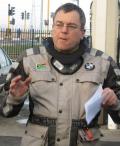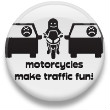Technical report :Riding through patches of wet mud or ice
Riding through patches of wet mud or ice
Twice now I have come down while riding through mud in sudden and violent falls with no apparent reason.
The fact that my fall was so sudden and immediate has vexed me.
Why did I go down so suddenly, so violently?
What are the dynamics and what to do next time.
Exactly a year ago on our 11-day Trip-to-Anywhere, Annie had a grand stand view of an identical event in mud as I was thrown violently by Rommel in mud.
But there’s an easy and ready explanation to it.
Knowing what that is, I can in future be more in control of my environment and maybe prevent such a catastrophic roll-over.
But on Saturday I thought I did everything right.
I was standing, I was looking up already.
I did All my training told me to do.
I opened my legs, lifted my elbows (to facilitate maximum suspension)
I kept looking up, that’s instinctive and I think I opened the throttle ever so slightly.
I called my guru, Captain oh my Captain, Leon husband to luscious Liezl, and as I went through my motions he immediately understood and told me what it was that threw me.
I threw myself off the bike.
This is as boxer motor issue, so only BMW boxer specific.
When you open the throttle in mud or snot, the front wheel, with no traction or resistances kicks-out to the left.
It only needs to slip one centimeter and it will throw you.
The trick is to keep neutral weight distribution front to rear – do not shift aft as in sand.
Keep neutral speed right through- don’t increase or decrease engine revs.
Do the rest- look up, stand up, open up knees and ride it out, and oh yes-
If you have a choice, choose a line on the lowest part so gravity is not any more your enemy then it already is.
Don’t believe me?
Ok, before pulling off next time you ride, standing astride your idling bike, in neutral, twist the throttle wide open and you’ll feel the bike pressure on your right thigh as it twists to the right.
Which means the front wheel is twisting left.
You can try this trick at home without parental guidance.
Catastrophic dynamic rollover. That’s what we call it in aviation terms.
It’s the torque effect. the coefficient of the friction in the crank-shaft makes the engine want to follow the rotation direction of the flywheel (or propeller) and if the engine is bolted into a frame it stands to reason the frame will follow the engine.
When the spitfire came out with the Griffin engine in ’42, a few fell violently to the ground shortly upon take-off. The Griffin with four blades on a Spitfire developed so much torque that as the pilot opened the throttle, the clawing prop spinning this way, the plane twisted with it (followed the prop) as the aerodynamics were not enough yet to hold her level..
This caused the wing tip to touch the ground with violent and disastrous results.
In fact I understand this is how one of our few flyable Spitfires in SA was damaged cat II in just such a dynamic roll-over event on take off. It was written off.
Soon as they understood dynamic roll-over they countered the effect by applying opposite aileron to ‘twist’ the plane counter to the prop rotation & left rudder, and no more accidents. the nett result was a straight n level climb out.
So next time I see mud ahead, I’ll use this knowledge powerfully well to keep the rubber side down by maintaining status, neutral balance and looking for the lowest part.
Of course the 650GS, 800GS and KTM’s don’t suffer dynamic roll-over when opening the throttle.
Well said.
A good operator never blames his tool.
to call you on this. Though the effect you describe (twisting of the bike) is correct, you have the cause slightly confused.
Catastrophic dynamic rollover. That’s what we call it in aviation terms.
It’s the torque effect. the coefficient of the friction in the crank-shaft makes the engine want to follow the rotation direction of the flywheel (or propeller) and if the engine is bolted into a frame it stands to reason the frame will follow the engine.
The stuff I looked up in Wikipedia told a different story. Catastrophic dynamic rollover does occur in a helicopter when you suddenly increase the pitch in the collective, but not because of friction in the crank - it is because of a moment about a stuck skid (for example), or, in a plane it is indeed due to the torque effect, which is described as (and I quote from wikipedia):
The torque effect experienced in helicopters and single propeller-powered aircraft is a result of Isaac Newton's third law of motion that "for every action there is an equal and opposite reaction"
In helicopters, the result of the torque effect is a tendency of the main rotor to want to turn the fuselage in the opposite direction from the rotor.
In a single-propeller plane, the result of the torque effect is a tendency of the plane to want to turn upwards and left in response to the propeller wanting to turn (bank) the plane in the opposite direction of the propeller spin.
In other words - nothing to do with friction in the crank, and in the exact opposite direction to what you say. Engine wants to rotate faster to the left = bike wants to tip to the right.
Sorry to nit pick but did the Spitfire not have the famous Rolls Royce V12 Merlin engine as used in the Shackleton and Lancaster bombers.




